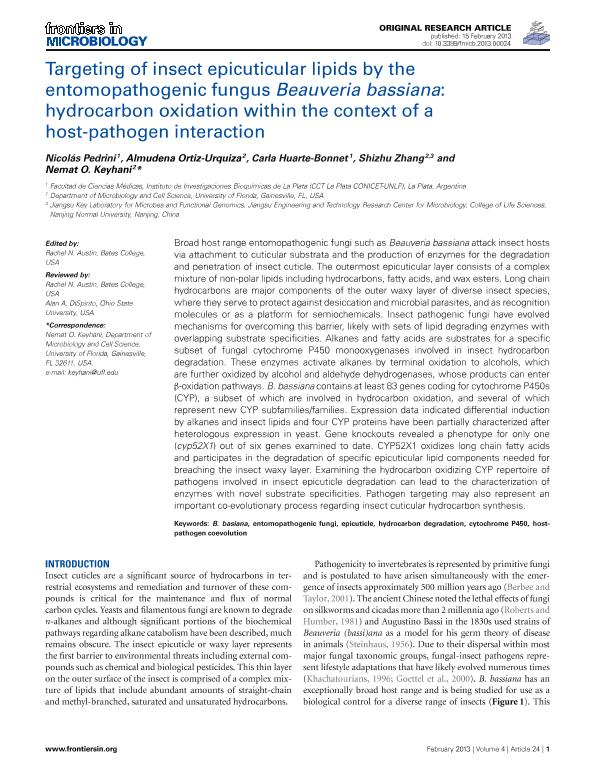Artículo
Targeting of insect epicuticular lipids by entomopathogenic fungi: hydrocarbon oxidation within the context of a host-pathogen interaction
Fecha de publicación:
15/02/2013
Editorial:
Frontiers Media S. A
Revista:
Frontiers in Microbiology
ISSN:
1664-302X
Idioma:
Inglés
Tipo de recurso:
Artículo publicado
Clasificación temática:
Resumen
Broad host range entomopathogenic fungi such as Beauveria bassiana attack insect hosts via attachment to cuticular substrata and the production of enzymes for the degradation and penetration of insect cuticle. The outermost epicuticular layer consists of a complex mixture of non-polar lipids including hydrocarbons, fatty acids, and wax esters. Long chain hydrocarbons are major components of the outer waxy layer of diverse insect species, where they serve to protect against desiccation and microbial parasites, and as recognition molecules or as a platform for semiochemicals. Insect pathogenic fungi have evolved mechanisms for overcoming this barrier, likely with sets of lipid degrading enzymes with overlapping substrate specificities. Alkanes and fatty acids are substrates for a specific subset of fungal cytochrome P450 monooxygenases involved in insect hydrocarbon degradation. These enzymes activate alkanes by terminal oxidation to alcohols, which are further oxidized by alcohol and aldehyde dehydrogenases, whose products can enter β-oxidation pathways. B. bassiana contains at least 83 genes coding for cytochrome P450s (CYP), a subset of which are involved in hydrocarbon oxidation, and several of which represent new CYP subfamilies/families. Expression data indicated differential induction by alkanes and insect lipids and four CYP proteins have been partially characterized after heterologous expression in yeast. Gene knockouts revealed a phenotype for only one (cyp52X1) out of six genes examined to date. CYP52X1 oxidizes long chain fatty acids and participates in the degradation of specific epicuticular lipid components needed for breaching the insect waxy layer. Examining the hydrocarbon oxidizing CYP repertoire of pathogens involved in insect epicuticle degradation can lead to the characterization of enzymes with novel substrate specificities. Pathogen targeting may also represent an important co-evolutionary process regarding insect cuticular hydrocarbon synthesis.
Archivos asociados
Licencia
Identificadores
Colecciones
Articulos(INIBIOLP)
Articulos de INST.DE INVEST.BIOQUIMICAS DE LA PLATA
Articulos de INST.DE INVEST.BIOQUIMICAS DE LA PLATA
Citación
Pedrini, Nicolás; Ortiz Urquiza, Almudena; Huarte Bonnet, Carla; Zhang, Shizhu; Keyhani, Nemat O.; Targeting of insect epicuticular lipids by entomopathogenic fungi: hydrocarbon oxidation within the context of a host-pathogen interaction; Frontiers Media S. A; Frontiers in Microbiology; 4; 15-2-2013; 1-18
Compartir
Altmétricas




